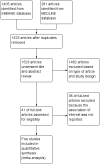Paroxysmal supraventricular tachycardia and risk of ischemic stroke: A systematic review and meta-analysis
- PMID: 31293699
- PMCID: PMC6595320
- DOI: 10.1002/joa3.12187
Paroxysmal supraventricular tachycardia and risk of ischemic stroke: A systematic review and meta-analysis
Abstract
Background: Paroxysmal supraventricular tachycardia (PSVT) has been traditionally considered as a benign rhythm disorder. However, recent studies have suggested that patients with PSVT may have a higher risk of ischemic stroke although the data are limited and inconclusive. The current systematic review and meta-analysis was conducted with the aims to identify all available studies and summarize their results together to better characterize the risk of ischemic stroke among patients with PSVT.
Methods: A comprehensive literature review was conducted by searching for published articles indexed in MEDLINE and EMBASE databases from inception through November 11, 2018 to identify all observational studies that compared the risk of ischemic stroke between patients with PSVT and individuals without PSVT. Pooled risk ratio (RR) and 95% confidence interval (CI) were calculated using a random-effect, generic inverse variance method of DerSimonian and Laird.
Results: A total 5 studies (4 cohort studies and 1 case-control study) with 4 886 977 participants met the eligibility criteria and were included into the meta-analysis. The risk of ischemic stroke among patients with PSVT was significantly higher than individuals without PSVT with the pooled RR of 2.03 (95% CI, 1.22-3.38, I 2 = 89%).
Conclusion: This study found that PSVT is associated with a higher risk of ischemic stroke. Whether this association is causal and how it should be addressed in clinical practice require further investigations.
Keywords: meta‐analysis; paroxysmal supraventricular tachycardia; risk factor; stroke.
Conflict of interest statement
All authors declare no conflics of interest for this article.
Figures
References
-
- Delacrétaz E. Supraventricular tachycardia. N Engl J Med. 2006;354(10):1039–51. - PubMed
-
- Orejarena LA, Vidaillet H, DeStefano F, Nordstrom DL, Vierkant RA, Smith PN, et al. Paroxysmal supraventricular tachycardia in the general population. J Am Coll Cardiol. 1998;31(1):150–505. - PubMed
-
- Al‐Zaiti SS, Magdic KS. Paroxysmal supraventricular tachycardia: pathophysiology, diagnosis, and management. Crit Care Nurs Clin North Am. 2016;28(3):309–16. - PubMed
-
- Cruz FE, Cheriex EC, Smeets JL, Atié J, Peres AK, Penn OC, et al. Reversibility of tachycardia‐induced cardiomyopathy after cure of incessant supraventricular tachycardia. J Am Coll Cardiol. 1990;16(3):739–44. - PubMed
-
- Katz DF, Sauer WH, Thai Nguyen D. Incessant supraventricular tachycardia in a patient with cardiomyopathy. Card Electrophysiol Clin. 2012;4(4):517–20.
LinkOut - more resources
Full Text Sources
Miscellaneous




